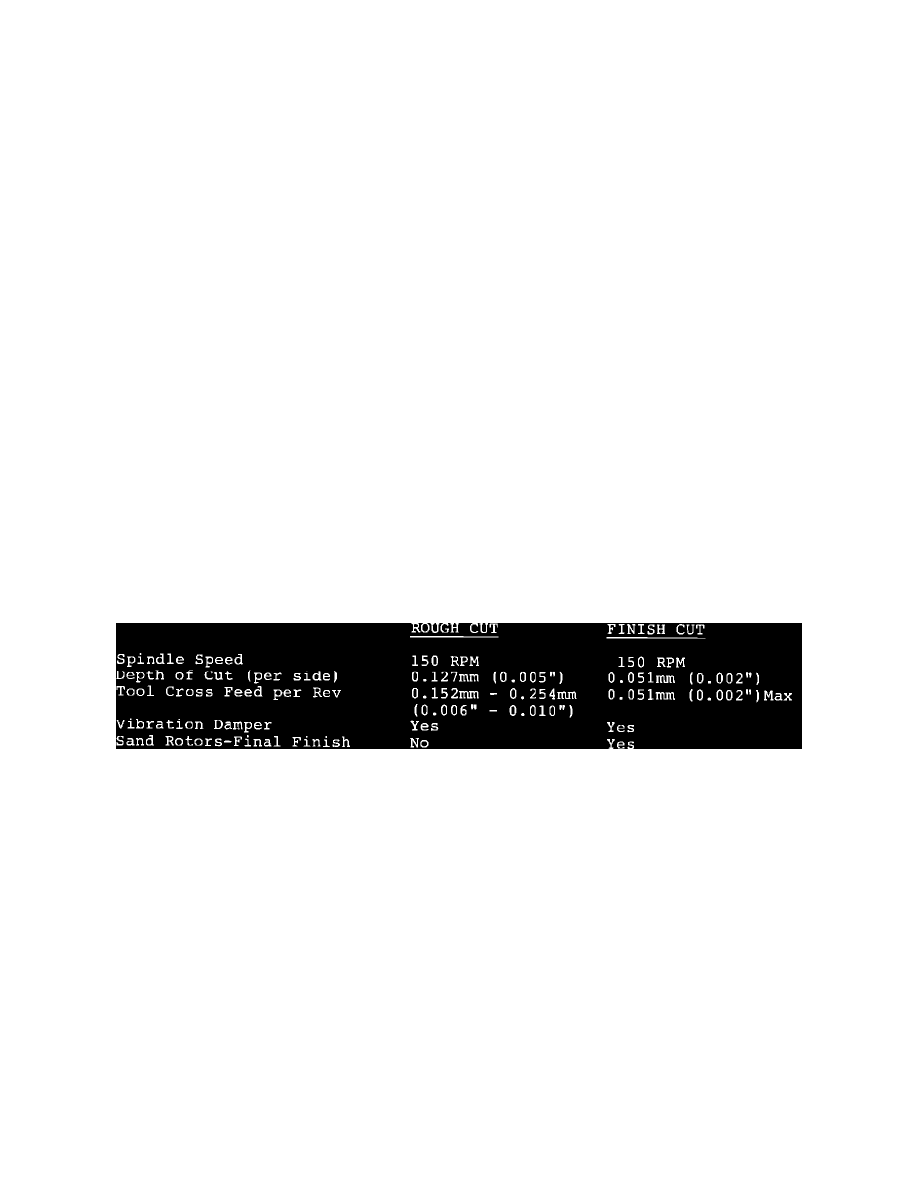Firebird V8-305 5.0L (1982)

Brake Rotor/Disc: Technical Service Bulletins
Brakes - Recommended Service Procedures
Bulletin Number:
91-5-4
Reference Number:
075003R
Publish Date:
12/90
Subject:
CHANGE IN BRAKE EFFECTIVENESS AFTER DISC BRAKE ROTOR REFINISHING/PAD REPLACEMENT
Models
Affected:
1982-91 ALL MODELS
This bulletin has been revised to add information about hub and rotor cleaning, proper torquing technique, revise machining table, change specification
for maximum scoring depth. This bulletin cancels and replaces bulletin 90-5-13 issued 8/90.
Some comments have been received about a change in perceived braking effectiveness which occurs after rotors have been refinished and/or disc brake
pads have been replaced. New lining materials have been formulated for increased lining life and to reduce brake squeal. Also, Federal regulations
currently prohibit the use of asbestos in Original Equipment Manufactured (O.E.M.) front disc brake linings, and will totally ban asbestos from all
O.E.M. brake linings in the near future. Due to these changes, initial rotor surface finish is more critical than in the past, and is required for good brake
performance.
Following are some recommended actions/procedures to assure proper performance of the brake systems on all vehicles after rotor and/or pad service
has been performed:
1.
When performirig routine brake maintenance such as replacing worn disc brake pads or shoes, DO NOT refinish disc brake rotors or drums unless:
A.
There is a brake pulsation condition present, and this pulsation is found to be caused by the brake rotors or drums, or
B.
The rotors and/or drums are excessively scored. Surface scoring that does not exceed 1.2 MM (0.050 in.) on rotors or drums should not
affect brake operation.
Before removing rotors from the hub assembly, mark the rotor and on wheel stud so that the rotor may be re-installed in the same position.
If rotors are removed, it is very important that rust and scale be removed from the rotor and hub mating surfaces. Failure to do so may introduce
excessive lateral runout when the rotor is mounted on the brake lathe, or when the rotor is re-installed to the hub.
2.
When refinishing disc brake rotors, it is important that the brake lathe be in good operating condition and that all tools or bits are sharp.
Recommended vibration dampeners and/or adaptors should be used and should be clean and free of nicks (remember, 1988-91 Grand Prix models
require the use of an adaptor, J37160, because of the two-piece design). The following table shows the recommended procedure for rotor
machining:
It is important that a rough and a finish cut be made. All brake lathes use a single-point cutting tool which is not capable of giving the necessary surface
finish. A SECONDARY FINISHING OPERATION MUST BE PERFORMED TO OBTAIN THE NECESSARY SURFACE FINISH.
An acceptable finish can be obtained using the Ammco Model 8350 Safe Swirl Disc Rotor Grinder, or equivalent, using 120 grit sandpaper and sanding
each rotor surface with moderate pressure for a minimum of 60 seconds with the rotor turning at 150 RPM. An alternate method is to use a sanding block
with 150 grit sandpaper. With the rotor turning at approximately 150 RPM, sand each side for a minimum of 60 seconds using moderate pressure.
After the rotor has been sanded, the surfaces must be cleaned with a solvent such as brake cleaning, denatured alcohol, or equivalent.
THE FINISHED ROTOR SURFACE SHOULD BE AS CLOSE TO THAT OF A NEW ROTOR AS POSSIBLE. FAILURE TO OBTAIN THE BEST
POSSIBLE ROTOR FINISH WILL AFFECT INITIAL BRAKING PERFORMANCE.
CAUTION: ROTORS OR DRUMS SHOULD ALWAYS BE REPLACED IF TURNING WILL RESULT IN A ROTOR OR DRUM THAT DOES
NOT MEET MANUFACTURER SPECIFICATIONS FOR MINIMUM ROTOR THICKNESS OR MAXIMUM DRUM DIAMETER.
NOTICE:
When re-installing tire and wheel assemblies, it is very important that proper procedures be followed when installing and torquing the
wheel nuts:
A.
Finger start all wheel nuts.
